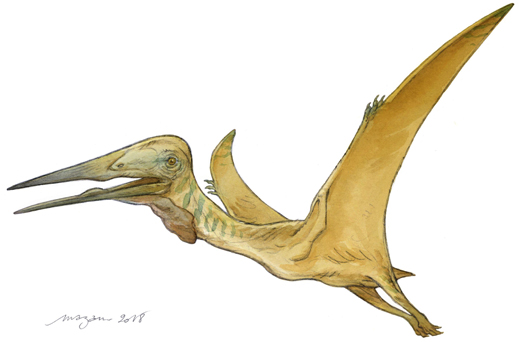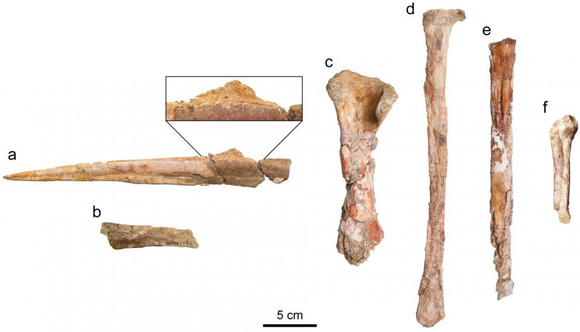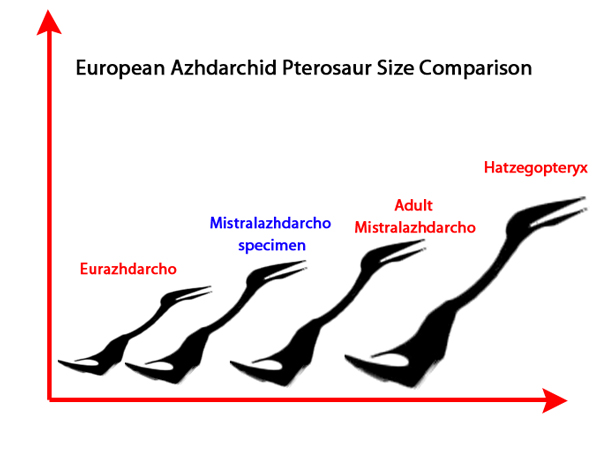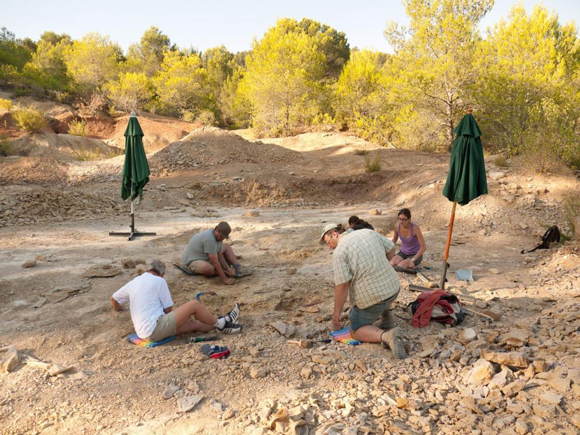A New Azhdarchid Pterosaur from France
Mistralazhdarcho maggii – From the Upper Cretaceous of France
A team of scientists based in France and Belgium have announced the discovery of a new species of pterosaur from Upper Cretaceous rocks in south-eastern France (Bouches-du-Rhône). The fragmentary bones have been assigned to the Azhdarchidae family of pterosaurs, one of the last groups of flying reptiles to exist and a family that contains giants such as Quetzalcoatlus and Hatzegopteryx. With a wingspan estimated to be around 4.5 metres, the specimen, believed to be a juvenile, provides evidence of a third azhdarchid pterosaur size class from the cluster of islands that represented continental Europe towards the end of the Mesozoic.
The pterosaur has been named Mistralazhdarcho maggii pronounced (miss-tral-ads-dar-cho may-gee).
A Life Reconstruction of the Newly Described French Azhdarchid Pterosaur – Mistralazhdarcho maggii

Picture credit: Pierre Lavaud
One of the Most Complete Pterosaur Fossils Known from Late Cretaceous Europe
Writing in the academic publication the “Journal of Vertebrate Paleontology”, the researchers describe the finding of part of a lower jaw, a neck bone and several other postcranial bones in 2009. The bones were found in association with each other and therefore, probably represent the fossilised remains of a single pterosaur. The material comes from the excavation site of Velaux, near Aix-en-Provence and from strata that dates to the Campanian faunal stage of the Late Cretaceous.
Views of the Fossil Material Ascribed to the New Pterosaur Mistralazhdarcho maggii
Picture credit: Royal Belgian Institute of Natural Sciences
The photograph (above), shows a part mandible (a) with a distinctive ridge (mandibular symphysis). A cervical vertebra (b), left humerus (c), left radius (d) and two bones from the hand – metacarpal IV (e) and a finger bone (f).
Although the fossil material is fragmentary, such is the poor fossil record of Late Cretaceous pterosaurs from Europe that these few bones make Mistralazhdarcho one of the most complete European azhdarchids described to date. In addition, Mistralazhdarcho is the first partial skeleton of a flying reptile excavated from Upper Cretaceous deposits of western Europe.
Related to a North African Pterosaur?
The scientists, which included researchers from the University of Rennes, the Royal Belgian Institute for Natural Sciences and Poitiers University, conclude that Mistralazhdarcho was related to an earlier pterosaur called Alanqa (A. saharica), which lived in North Africa around 95 million years ago. When Alanqa was first described, back in 2010, it was assigned to the Azhdarchidae, but more recent studies incorporating skull material discovered in 2015, have cast doubt on the taxonomic position of Alanqa.
To read about the discovery of Alanqa saharica: Dublin Team Announce the Discovery of a New Pterosaur.
An Adult Probably Had a Wingspan of Around 5-6 metres
Examination of the fossil bones suggest that they were not fully ossified and that this was a sub-adult. The researchers speculate that a fully-grown Mistralazhdarcho would have had a wingspan of around 5 to 6 metres, possibly even bigger. This size estimate is in between the size estimates given for the two azhdarchids from the Maastrichtian of Romania (Hateg Formation), which also represents the European Late Cretaceous archipelago environment.
A Size Comparison of European Azhdarchid Pterosaurs
Picture credit: Everything Dinosaur
Mistralazhdarcho is estimated to be intermediate in size between the medium-sized genus Eurazhdarcho (wingspan of 3 metres) and the enormous Hatzegopteryx (estimated wingspan of 10 metres or more), the two other azhdarchids associated with the island ecosystem of the latest Cretaceous European archipelago. The different sized pterosaurs might reflect a form of niche partitioning, whereby, different sized animals did not directly compete with each other for resources.
The flying reptile’s genus name is from the “mistral”, a strong, north-westerly wind associated with southern France. The species name honours the former mayor of Velaux, Jean-Pierre Maggi, without whom, the excavation of the fossil material would not have been possible.
Field Team Members Working at the Velaux Excavation Site
Picture credit: Royal Belgian Institute of Natural Sciences
The scientific paper: “Mistralazhdarcho maggii, gen. et sp. nov., a New Azhdarchid Pterosaur from the Upper Cretaceous of south-eastern France” by Romain Vullo, Géraldine Garcia, Pascal Godefroit, Aude Cincotta and Xavier Valentin published in the Journal of Vertebrate Paleontology.
Visit the Everything Dinosaur website: Everything Dinosaur.




